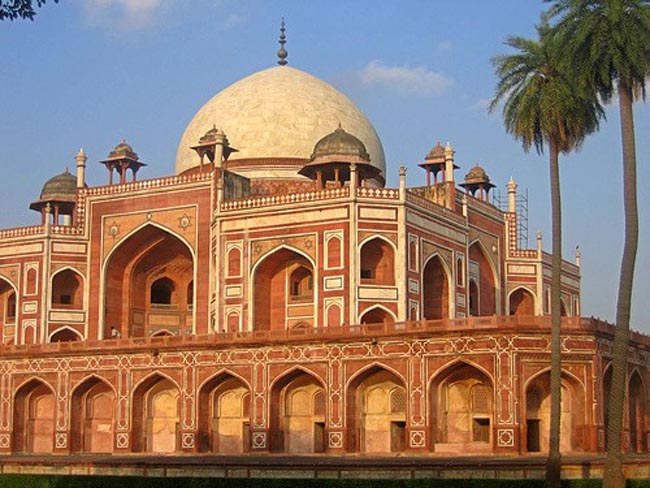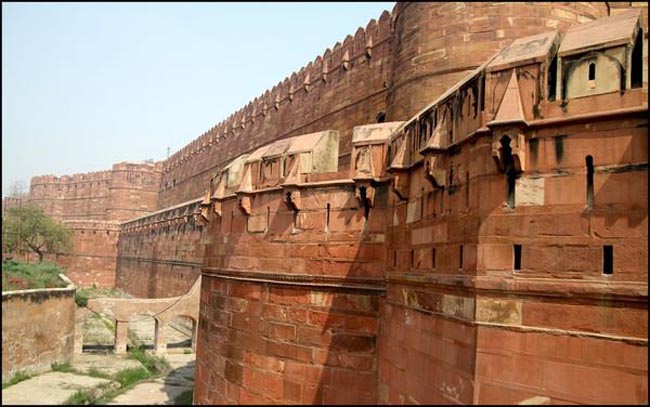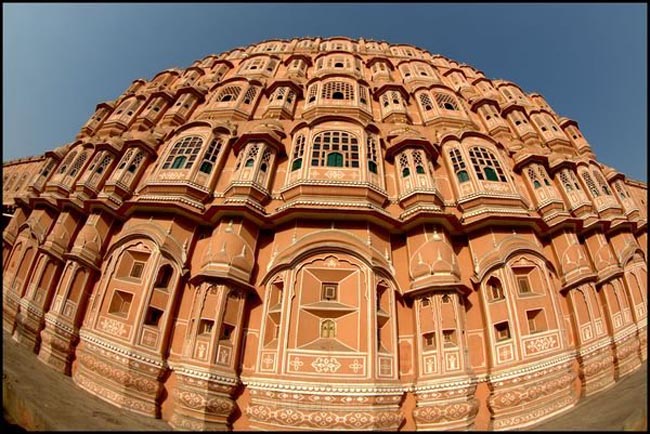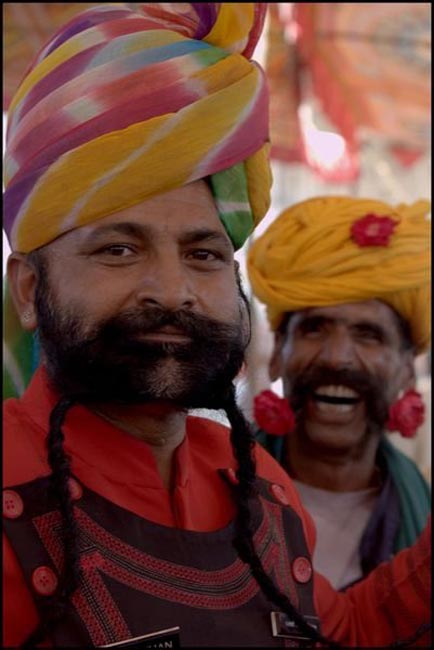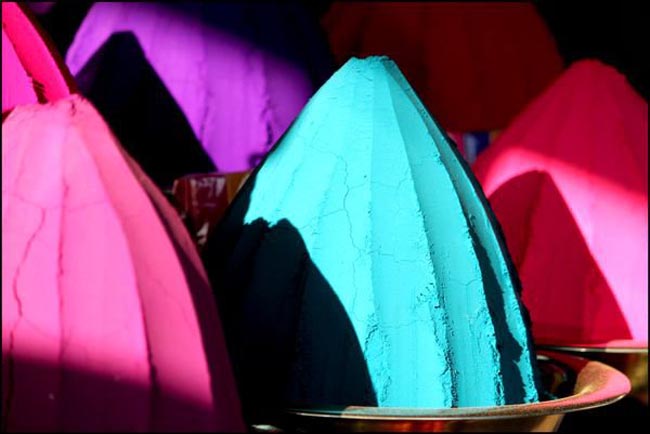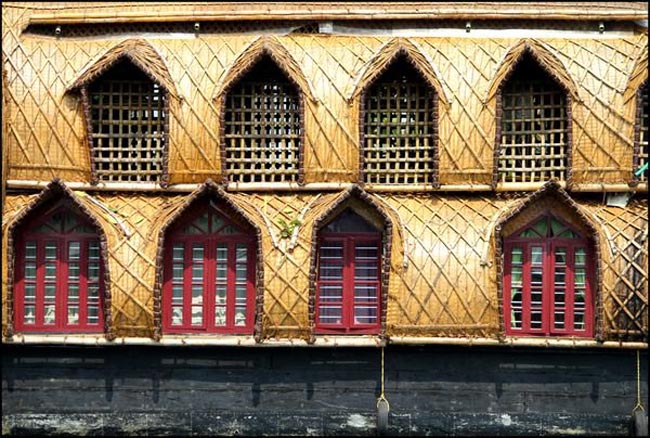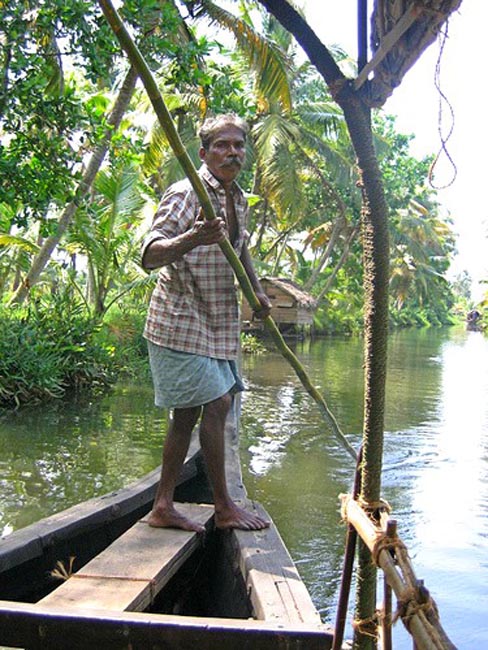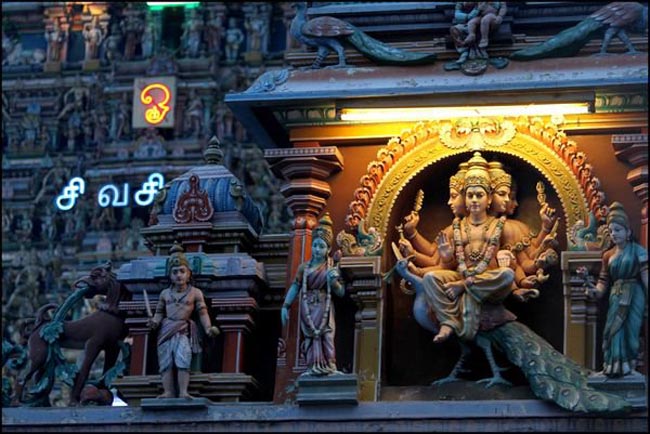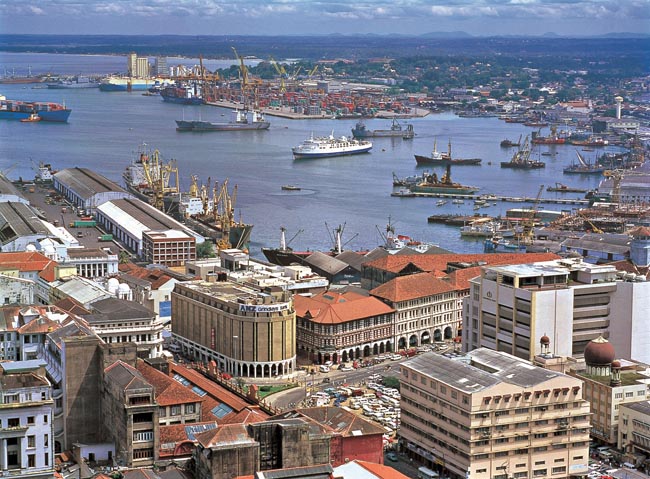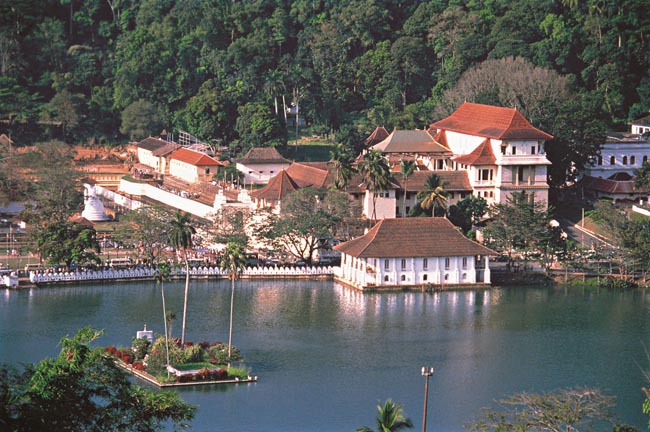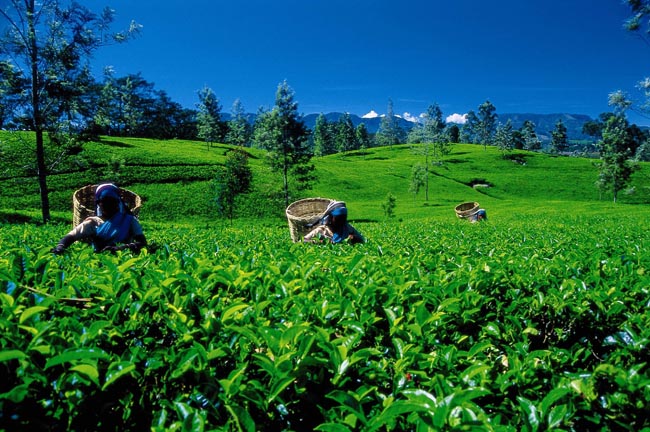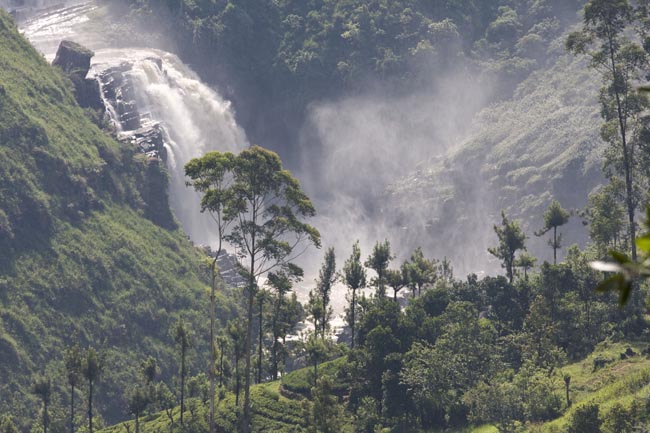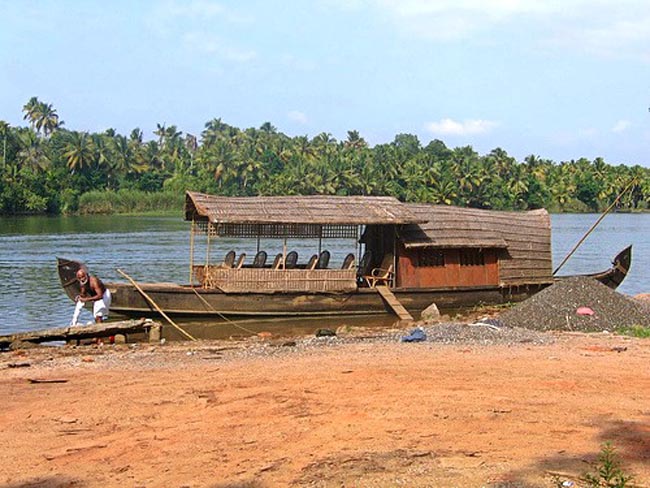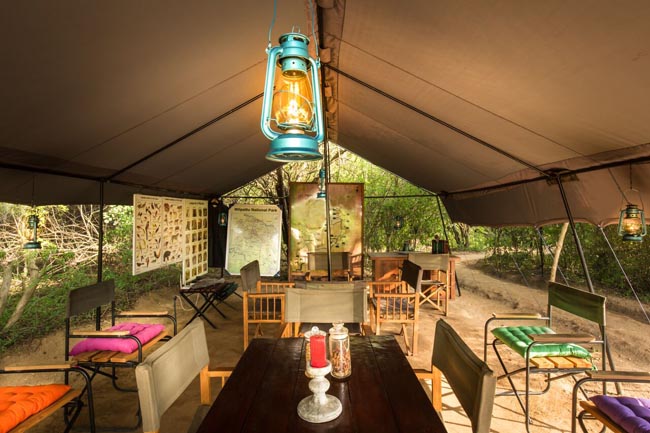Download Itinerary
Day 1 Arrival in Calcutta
Today we arrive in Calcutta.
Overnight in Calcutta.
Included Meal(s): Dinner
Day 2 Calcutta - Fly to Darjeeling
We fly to the market town of Siliguri (Bagdogra Airport) in North Bengal and then start our 3-hour drive from the plains to Darjeeling along a road that soon leaves the rice fields and coconut palms of the lowlands for the tea plantations of the lower hills. Driving close beside the narrow gauge Darjeeling Hill Railway drawn by century old steam engines, we reach the halfway point of Kurseong where we stop for a tea break before driving to Ghoom at about 2400m / 8,000 ft There is a 350m / 1,000 ft descent into the busy town of Darjeeling.
Darjeeling or 'the place of the thunderbolt' and the surrounding area once belonged to the rulers of Sikkim. In 1833 the British gained control of the hill on which Darjeeling stands after considerable political maneuvering in return for a small annual payment to the King of Sikkim. It soon grew to a popular health resort after a pony road and some houses were built and tea growing introduced. Later in the 19th century, the remarkable mountain railway from the plains was built and Darjeeling boomed as a resort and holiday destination for the British bureaucracy wanting an escape to cooler climates.
Built on a crescent shaped ridge, Darjeeling (2134m / 7,042 ft) faces the Himalayan peaks and is surrounded by cultivated slopes, thick forests and tea plantations.
Overnight in Darjeeling.
Included Meal(s): Breakfast and Dinner
Not finding what you're looking for?
Our specialists can take away the stress and create a private custom tour tailored to your exact interests and budget.
Day 3 Darjeeling: Everest Sunrise & Ghoom Monastery
We are woken before dawn with a cup of tea before making the 15 km drive to Tiger Hill to see the amazing colours of sunrise on Kanchenjunga. At 2550 m / 8,500 ft, Tiger Hill commands superb views of the mountains and valleys of the eastern Himalaya with Everest, Lhotse and Makalu visible in the far distance on clear days. We stop at Ghoom monastery on the way back; this monastery built in 1875 belongs to the yellow hat (Gelugpa) sect lamas and has a 5-metre high statue of the Maitreyi (future) Buddha.
In the afternoon, we will tour the Himalayan Mountaineering Institute and the small zoo beside it has several interesting Himalayan species. The institute itself houses a considerable collection of items used by the early Everest explorers and also has a fine topographical model of the Eastern Himalaya. Later we drive to a nearby tea plantation for which this region is famous and see the picking and processing of tea leaves. Sometime during the day, we will make a quick visit the Tibetan Refugee and Handicraft Centre where Tibetan refugees live cooperatively and their children attend school while their parents work on wool making, carpet weaving and handicraft production.
The rest of the day is free to browse the 'Chowrasta' or town square and explore the well-known Oxford Book Shop with its excellent collection of books on the history and cultures of the Himalaya. You could also walk down to the Lower Bazaar where the local residents shop for produce, fabrics and spices.
Overnight in Darjeeling.
Included Meal(s): Breakfast and Dinner
Day 4 Darjeeling - Gangtok (Sikkim)
We have an early departure for our steep descent through a series of tea plantations to the tropical Teesta Valley. Passing through sal forests and cinchona (quinine bark) plantations, we stop briefly at the Teesta Bridge checkpoint to show our Sikkim entry documents before continuing onwards to Gangtok, the capital of Sikkim.
Located in the Eastern Himalaya, Sikkim forms a natural border between Nepal to the west and Bhutan to the east. To the north lies Tibet and to the south the Teesta and Ringgit rivers form a natural boundary with the Indian state of West Bengal; to the east lies the Kingdom of Bhutan separated by a tongue of Chinese controlled Tibet.
The climate is subtropical in the lower valleys, but changing fast to temperate and alpine with increase in elevation. Vast rhododendron forests cover most of the slopes between 3300-4000 m (10,800-13,000 feet) and the Himalayan cypress is widely found near the tree line. Mixed forests of bamboo and dozens of orchid species are common between 1500-3000 m (5,000-9,850 feet) -- 660 varieties of orchids are known to grow in Sikkim. The cardamom spice is a cash crop that grows wild extensively around Yuksum and Phodang.
Later today we will visit the Institute of Cottage Industries where young Sikkimese people are taught traditional crafts. There is a sales centre attached for a number of local handicrafts, most with a strong Tibetan look to them. Woollen carpets, shawls and traditionally painted tables are good buys, all at government regulated prices.
Overnight in Gangtok.
Included Meal(s): Breakfast and Dinner
Day 5 Gangtok: Area Tour - Kalimpong
A brief drive to Rumtek Monastery on the opposite side of the valley from Gangtok. Rumtek is the seat of the Tibetan Kagyugpa sect of monks and a major centre for Tibetan religious studies. The 16th Gwalpa Karmapa, the head of the Kagyugpa sect, took refuge in Rumtek after the Chinese invasion of Tibet in the 1950's; he and his followers escaped with whatever statues, 'thangka' paintings and scriptures they could and built Rumtek monastery as a replica of the Chhofuk monastery that they had left behind in Tibet.
A scenic drive past forest covered slopes and fast flowing rivers to Kalimpong (1250 m / 4,100 feet), an important market town located strategically at the crossroads of Tibet, Bhutan, Nepal and Bengal until the 1960s when the Indo-China war put an end to cross border trade. It is now well known for its numerous flower and orchid nurseries.
We stay in the Himalayan Hotel, run by Tim MacDonald, grandson of the Tibetan explorer David MacDonald, who accompanied many of the early British Younghusband expeditions to Tibet around the turn of the century. The MacDonald family home is something of a museum to the early exploration of this part of the Himalaya; its 16 rooms decorated with memorabilia donated by notable Himalayan explorers who have stayed at the hotel over the years. The main house was built in the 1920s and has a mature garden with dozens of varieties of flowering trees and shrubs and views of the Himalaya from the verandahs.
Overnight in Kalimpong (1247 m / 4,100 ft).
Included Meal(s): Breakfast and Dinner
Day 6 Kalimpong: Area Tour - Siliguri
Today we historic home of Dr Graham and the extensive boarding and day school facilitiy that was established over a century ago. We will see its classrooms and boarding houses to get an idea how students of both sexes from all over India and neighbouring countries like Bhutan spend their days during the study year. There is an Anglican church with fine stained glass windows nearby, and you can also visit one of the flower nurseries for which Kalimpong is well known across India.
Late afternoon, we descend to the Teesta River Valley and drive to the important market town of Siliguri and onwards to our hotel located on the northern outskirts of town.
Overnight in Siliguri.
Included Meal(s): Breakfast and Dinner
Day 7 Siliguri - Bagdogra - Delhi
Today we drive down to the plains of North Bengal and the airport of Bagdogra from where we fly to Delhi.
The name Delhi, Dehali or Dilli is derived form Dhillika, the name of the first medieval township of Delhi, located on the southwestern border of the present Union Territory of Delhi, in Mehrauli. This was the first in the series of seven medieval cities, also known as Yoginipura, the Fortress of the Yoginis (female divinities).
Overnight in Delhi.
Included Meal(s): Breakfast and Dinner
Day 8 Delhi: City Tour
Today we have a full-day tour of Delhi. We start with a drive north into Old Delhi, passing along the Rajpath (King's Way) and stopping for photos at the India Gate. The 42m high India Gate, an "Arc de Triomphe"-like archway in the middle of a crossroad, commemorates the Indian soldiers who lost their lives fighting for the British Army during WWI. This landmark also bears the names of British and Indian soldiers killed in the Northwestern frontier in the Afghan War of 1919.
Next we will make a visit to the Jamma Mosque. Located in the heart of Old Delhi, the largest mosque in India can accommodate as many as twenty-thousand worshippers. This imposing architectural monument, with it's three gateways and two minarets, took fourteen years to complete (1644-58). We will also enjoy a cycle-rickshaw ride down Chandni Chowk once the imperial avenue down which Shah Jehan rode at the head of lavish cavalcades.
We will re-board our bus, going past the Red Fort (photo stop), and we disembark at the Raj Ghat, set within a beautiful park. This national monument is where the father of the nation, Mahatma Gandhi, was cremated.
After a stop for lunch we continue our sightseeing with a visit to Humayan's Tomb, an excellent example of Mughal architecture, pre-dating the Taj Mahal by almost 100 years. Persian in style, this is a beautiful red sandstone building inlaid with black and white marble.
We will finish our day with a visit to the Qutub Minar. Few other monuments are as closely identified with Delhi as the Qutub Minar, this first monument of Muslim rule in India. It heralded the beginning of a new style of art and architecture which came to be know as the Indo-Islamic.
Overnight in Delhi.
Included Meal(s): Breakfast and Dinner
Day 9 Delhi - Varanasi & Sarnath
This morning we fly to Varanasi.* After a break at our hotel we embark on our afternoon sightseeing program.
With more than 2,000 temples and shrines Varanasi has been the religious capital of the Hindu faith since its beginning. No one knows how old it really is -- when Buddha came here in 550 BC it was already a flourishing ancient settlement. The town is a maze of small streets and alleyways, hiding no fewer than 2,000 temples and shrines. Domes, pinnacles, towers and derelict 18th century palaces dominate the left bank of the Ganges River.
The antiquity of Varanasi can be traced back to at least the middle of first millennium BC. Since time immemorial, it has served not merely as holy center of pilgrimage, but also as a great seat of traditional Hindu learning and culture.
This afternoon we take a short journey to the buried city of Sarnath. After attaining enlightenment at Bodh Gaya the Buddha went to Sarnath; and it was here that he preached his first discourse in the deer park to set in motion the 'Wheel of the Dharma'. It is one of the most holy sites as in this place the stream of the Buddha's teaching first flowed. The Dhamekh Stupa, Dharmararjika Stupa (the Main shrine where the Buddha sat in meditation), the sacred promenade from where he preached, and the Ashoka Pillar are monuments that still stand today.
* Please note: You will notice that in the Northern portion of our India itineraries contains some days that are conditional in their content, depending on which date the trips operates and the various festivals they include. Those who book will receive a more detailed itinerary specific to their chosen date prior to departure. Please also note that from Fall 2013, this tour will be re-designed; many of the same highlights will be included, but the order will be updated and we will not include any festivals.
Overnight in Varanasi.
Included Meal(s): Breakfast and Dinner
Day 10 Varanasi - Khajuraho
Early this morning we take a boat ride on the sacred Ganges. Hindus regard the Ganges as the elixir of life bringing purity to the living and salvation to the dead. At dawn, thousands stand waist-deep in water praying to the rising sun. At dusk, hymns and prayers are uttered by the faithful in the light of hundreds of lighted lamps. The bathing ghats, over three miles in length, lead down from a steep bank to the river. Manikarnika burning ghat is the chief cremation
centre of Varanasi.
We will have a walk through the narrow streets of Varanasi before returning to our hotel.
Later this morning, we fly to Khajuraho, renowned the world over for its fine temples. Built between AD 950 and 1050, these temples are among the most creative examples of Indian architecture, of which only 22 of the original 85
temples survive.
We visit the western group of temples, contained within a fenced enclosure and maintained as a park. The Lakshmana Temple is dedicated to Vishnu and is one of the earliest, dating from AD 930-950. It is also one of the best preserved, with a full five-part floor plan and four subsidiary shrines. We also visit the eastern group of temples. These can be subdivided into two groups: a complex of Jain temples in the walled enclosure, and a group of four temples scattered through the small village of Khajuraho. Parsvanath is the largest of the Jain temples and also the finest in Khajuraho, noted for the exceptional skill and precision of its construction and for the beauty of its sculptures. The Adinath Temple has fine carvings on its three bands of sculptures. The Shanti Nath Temple is a relatively modern one, built about a century ago, but it contains many components from older temples around Khajuraho.
Khajuraho has achieved fame for the sensual appeal of the erotic sculptures, but these form only a small part of the wealth of the site. Taken in totality, the sculptures of Khajuraho depict the everyday life of the people and the court in the 10th and 11th centuries.
Overnight in Khajuraho.
Included Meal(s): Breakfast and Dinner
Day 11 Khajuraho - Jhansi - Agra
We continue by road to Jhansi, visiting the palace at Orchha, the former capital of the Bundela Dynasty. From Jhansi we catch the 18:00 train to Agra, arriving at approximately 20:00.
Agra continues to be medieval in structure: narrow, crowded streets and lanes, full of colourful shops sell that all kind of goods, especially local handicrafts, including gold and silver embroidery, imitation Mughal inlay on marble, and fine leather goods. Agra Fort lies on the bend of the River Yamuna, almost in the heart of the town. It was built by Akbar as his citadel over the years 1565 to 1573 in the finest architectural style . It has imposing gates and walls of red sandstone and a moat. The fort was successively occupied by three great Mughals -- Akbar, Jahangir and Shah Jehan, each of whom made significant structural contributions to this complex.
Overnight in Agra.
Included Meal(s): Breakfast and Dinner
Day 12 Agra: the Taj Mahal & Agra Fort
Today we tour the city and visit its main attraction: The Taj Mahal, one of the world's most beautiful buildings. Called "A dream in marble," the Taj Mahal was built by Shah Jehan as a memorial to his queen Mumtaz Mahal. Shah Jehan built the Taj to enshrine the body of his favourite wife, Mumtaz Mahal (elect of the palace), who died shortly after giving birth to their 14th child in 1631.
Construction by a work force of 20,000 men from all over Asia commenced in1632 and the tomb was completed in 1653. Marble was brought from Makrana, near Jodhpur, and precious stones of onyx, amethyst, malachite, lapis lazuli, turquoise, jade, crystal and mother of pearl were carried to Agra from Persia, Russia, Afghanistan, Tibet, China and the Indian Ocean.
The Taj is remarkable for its perfect proportions and rich pietra dura, with minute details executed with great skill. The building marks the most developed stage of Mughal architecture. The designer of this grand sepulchre is believed to be Ustad Ahmad Lahori, a master architect of the age. The calligraphic ornamentation on the Taj was authored by Amanat Khan Shirazi, a great writer of the 17th century.
The balance of our day will be spent visiting some of Agra's other remarkable monuments such as the Agra Fort, as rugged as the Taj Mahal is ethereal where we will have a chance to view the perfectly-proportioned Moti Masjid (Pearl Mosque) and have a visit to the Itimad-ud-daulah Mausoleum on the other side of the Yamuna River.
Overnight in Agra.
Included Meal(s): Breakfast and Dinner
Day 13 Agra - Jaipur
After leaving Agra we will visit Fatehpur Sikri, an ancient capital of the Moghul Empire built by Emperor Akbar the Great between 1569 and 1585. It was later abandoned due to the lack of a dependable water supply, but remains one of the most perfectly preserved examples of a Moghul city. Now deserted, it is almost perfectly preserved, a masterpiece in sandstone glowing in subtly changing shades of pink and red as the day progresses and the light fades. The very embodiment of Akbar's unorthodox court, the city fuses Hindu and Muslim artistic traditions.
Jaipur has been dubbed the "Pink City" because of the many buildings inside the old city walls that are painted pink. Scattered throughout the northeast section of the town are palaces and temples designed in a variety of styles; the city lies snugly on a bed of a long-dry lake.
Overnight in Jaipur.
Included Meal(s): Breakfast and Dinner
Day 14 Jaipur - Amer Fort - Jaipur
Today our tour takes us to the Amer Fort (aka Amber Palace), once the ancient state capital but now deserted. Located on the crest of a rocky hill behind Maota Lake, 11 km (7 miles) north of Jaipur, the Rajput stronghold was the capital of the Kuchhawa Rajputs from 1037 until 1728. Rising on the slopes of a steep hill is the Amer Fortress with its imposing facade. The interior presents a galaxy of art including the world's best Chamber of Mirrors.
In the afternoon we have a tour of Jaipur, one of the best-planned cities in India, built of rose-pink sandstone by the great astronomer-king Jai Singh II in 1727. Wer stop at the City Palace in the centre of the city, part of which is still the Maharaja's residence. The complex has been developed into a museum containing rare manuscripts, fine specimens of Rajput and Mughal paintings, royal apparel, and an armoury. We pass by the Hawa Mahal (Palace of Winds), the landmark of Jaipur, a curious building, elaborate and fanciful, built of pink sandstone with a delicate honeycomb design. Rising five storeys high, it is composed of semi-octagonal overhanging windows, each with its perforated screen, which allowed the ladies of the court to look onto the main street without being seen.
While in Japur, we'll have a guided walk through the local market -- a busy, noisy, colourful place with a lot going on, and an intriguing look into local life.
Overnight in Jaipur.
Included Meal(s): Breakfast and Dinner
Day 15 Jaipur to Pushkar OR Jaipur to Jodhpur
Our AUTUMN departure will travel to Pushkar in order to take in the Pushkar Camel Fair.
NOTE: The Camel Fair is a 15-day event, the last four days of which are open to tourists. During this time, the Department of Tourism arranges different events daily -- camel races, turban tying, folk dances, magic shows, puppet shows, etc. Unfortunately the programmes are NOT announced in advance so it is impossible for us to provide an exact listing of the activities that we will be able to witness. Sightseeing will include a town tour featuring the holy Pushkar Lake and the Brahmaji Mandir temple (one of the only temples in all of India devoted to Brahma).
FEB / MAR DEPARTURES: On these dates we will travel to Jodhpur and have a tour on arrival.
Jodhpur is a place of wonderful bazaars, where you can seek out puppeteers and dyers and get a real taste of rural Rajasthan. Our sightseeing in Jodhpur includes a visit to the massive fort which stands upon a rocky hill and engulfs the city with its 10 km (6 miles) of wall and eight gates. A fairly steep climb leads up through seven gateways. The palaces within are carved from a hard sandstone which the sculptors' chisels have carved as if it were soap. An extensive museum displays howdahs, paintings, thrones, banners, doors, weapons and a spectacular 17th century tent.
Overnight in Pushkar (autumn) or Jodhpur.
Included Meal(s): Breakfast and Dinner
Day 16 Pushkar to Jodhpur OR Jodhpur to Jaisalmer
OUR AUTUMN DEPARTURE coincides with the Pushkar Camel Fair, on the full moon of the Hindu month of Karttika, when over 200,000 buyers, sellers and hawkers have traditionally invaded this peaceful, holy village. After taking in the sights and sounds of the camel fair in the morning, we will depart after lunch for our 4-hour drive to Jodhpur (please note that 2012 will be our last tour to visit the Camel Fair. This tour will be re-designed for 2013 and will not include this festival).
Our February tour will travel instead to Jaisalmer, the land of the Bhatti princes, born of the moon, dates back to AD 1156. The skyline holds kiosks with parapets, balconies and terraces. Jaisalmer has been called the "Golden City" because of the colour imparted to its stone ramparts by the setting sun. This morning we visit the city gates and the massive fort inside, which rises majestically above the city. The fort itself is a warren of narrow,
paved streets complete with beautiful Jain temples.
Our February 2013 departure will coincide with the famous Jaisalmer Desert Festival when the sands come alive with the brilliant colours, music and laughter. Dressed in brilliantly hued costumes, the people of the desert dance and sing haunting ballads of valor, romance and tragedy. The fair has snake charmers, puppeteers, acrobats and folk performers.
Camels, of course, play a stellar role in this festival, where the rich and colourful folk culture of Rajasthan is on show. Over the years, the desert dwellers in their solitude have woven a fascinating tapestry with threads of music and rhythm and the Desert Festival is a celebration of their heritage.
Overnight in Jodhpur OR Jaisalmer.
Included Meal(s): Breakfast and Dinner
Day 17 Jaisalmer OR Jodhpur
AUTUMN 2012: This trip will spend the day in Jodhpur. Our sightseeing in Jodhpur includes a visit to the massive fort which stands upon a rocky hill and engulfs the city with its 10 km (6 miles) of wall and eight gates. A fairly steep climb leads up through seven gateways. The palaces within are carved from a hard sandstone which the sculptors' chisels have carved as if it were soap. An extensive museum displays howdahs, paintings, thrones, banners, doors, weapons and a spectacular 17th century tent.
Our February 2013 trip will spend an additional night in Jaisalmer.
Overnight Jodhpur (autumn) or Jaisalmer.
Included Meal(s): Breakfast and Dinner
Day 18 Jodhpur to Kumbalgarh OR Jaisalmer to Rohet
AUTUMN DEPARTURE: We will depart Jodhpur for our three to four hour drive to Ranakpur and its intricately carved Jain Temple. We will have the opportunity to visit the temples and have some lunch in this small village at the entrance to the Aravalli Hills. Afterwards, we will make our way to the nearby off-the-beaten-track hill fort town of Kumbalgarh, a strategic fort of the Mewar Kingdom. On our approach we will be passing through rustic villages and hilly terrain. The fort itself offers commanding west-facing views from a ridge of the Aravalli Hills. We aim to stay in
Kumbalgarh for a night at the heritage hotel situated in the fort itself. However, due to the limited rooms available we may opt to stay in the nearby village of Ranakpur, close to the site of the Jain Temple.
February: This departure will travel to Rohet for overnight. Avoiding central Jodhpur (already visited) will better-place us for tomorrow's trip to Udaipur.
Overnight in Kumbalgarh (autumn) OR Rohet.
Included Meal(s): Breakfast and Dinner
Day 19 Kumbalgarh to Udaipur OR Luni to Udaipur
After breakfast we drive to Udaipur through the picturesque Aravalli Hills, passing through small villages and bountiful agricultural land.
Overnight in Udaipur.
Included Meal(s): Breakfast and Dinner
Day 20 Udaipur: Area Tour
Today we see the lakeside City Palace, made up of eleven constituent mahals (palaces) constructed by successive Maharajahs over 300 years. Together they comprise the largest royal complex in Rajasthan. The palace, iridescent with tile and mirror inlays, includes the impressively carved Jagdish Temple dedicated to Lord Vishnu.
The afternoon is free to browse in this beautiful city of temples, fairy-tale palaces and vast city gardens surrounding several lakes. This is only one of the seven major Rajput states to uphold its Hindu allegiance in the face of Muslim invasions and political compromises. The present nobility are perhaps the longest surviving dynasty in the world, being the seventy-sixth in the unbroken line of Mewar suzerains. An afternoon drive around nearby Fateh Sagar Lake concludes an inspiring day.
Overnight in Udaipur.
Included Meal(s): Breakfast and Dinner
Day 21 Udaipur - Mumbai: City Tour
Today we fly to Mumbai. We are met on arrival and transferred to the hotel.
After freshening up, depart on a tour of the city. From humble obscure beginnings as a set of seven small islands, Mumbai (earlier called Bombay) has today risen to the eminence of India's most important commercial and industrial centre. At Dhobi Ghat, you can see a bewildering range of India’s contrasts. The dhobis (washermen) deal with staggeringly large washes every day. The Gateway of India was conceived as a triumphal arch to commemorate the visit of King George V and Queen Mary for the Delhi Durbar in 1911. The city has several fine examples of colonial architecture including the Afghan Memorial Church, established in 1847 which has Gothic arches and stained-glass windows; the Clock Tower - now called Rajabai Tower, the School of Art, built in the late 1800s, where Rudyard Kipling was born; Crawford Market which has bas-reliefs designed by Kipling's father; the massive Victoria Terminus and the Municipal Corporation building. Also of interest are the Hanging Gardens on Malabar Hill, from where you get a magnificent panoramic view of the metropolis and the Arabian Sea. Marine Drive is a long gracefully curving road along the buttressed seacoast.
Overnight in Mumbai.
Included Meal(s): Breakfast and Dinner
Day 22 Mumbai - Aurangabad: Ellora
Early morning transfer to the airport for the flight to Aurangabad. We are met on arrival and transferred to the hotel (Check-in at noon).
In the afternoon visit Ellora, which has 34 rock-cut temples representing the Buddhist, Jain and Hindu Brahmanic faiths. All the cave temples are man-made. The artists who flocked to these remote areas from vast distances literally hammered monuments out of rock, working usually from the top of the temple and moving downwards, to eliminate the need of scaffolding. The centre piece at Ellora is the Kailash Temple. In its galleries are recreated various scenes from Shiva myths. Although the carvings are of three religions, the structures are often similar. However, differences are visible -- the Jain carving are ascetic, the Buddhist caves, inspired by Buddhism's attempt at populism, show an austere richness.
Overnight in Aurangabad.
Included Meal(s): Breakfast and Dinner
Day 23 Aurangabad: Ajanta Caves
After breakfast take a day trip to Ajanta, located 100 km from Aurangabad. The 30 caves not only contain sculptures but remarkably preserved frescos as well. The Ajanta caves are in a secluded site; because of this they were virtually forgotten and discovered accidentally only in the 19th century. The frescos and sculptures are startling in the voluptuousness of much of the imagery for Buddhism was a religion of denial. The Buddha forbade the worshipping of idols and the wearing of colourful clothing or any ornamentation, which might excite desire. After the Buddha's death, its preachers began to tell stories of Buddha's earlier incarnations. Thus began the process of Buddhism acquiring some of the sensuousness of Hinduism. Return to Aurangabad in the late afternoon.
Overnight in Aurangabad.
Included Meal(s): Breakfast and Dinner
Day 24 Aurangabad - Mumbai - Goa
We have a morning flight to the former Portuguese enclave of Goa (via Mumbai).
Goa achieved fame when Portuguese navigator Vasco da Gama sailed down the Malabar Coast in 1498 in search of "Christians and spices." Although he found neither, Goa became a Portuguese colony separated from the rest of India by the jungle covered hills of the Western Ghats. Goa's heartland and population is located in the alluvial strip inland from the beaches, a lush patchwork of paddy fields, coconut plantations, whitewashed churches and gently meandering rivers.
Overnight in Goa.
Included Meal(s): Breakfast and Dinner
Day 25 Goa: City Tour
This morning we include a sightseeing tour of Panjim. Proceeding to old Goa, we visit the Basilica of Bom Jesus, built in 1605 by the Jesuit fathers and still the most important church in Goa. Enshrined in a silver casket in one of its chapels, is the body of Saint Francis Xavier. Across the street is the Se Cathedral with an imposing vaulted roof, massive pillars and fourteen magnificent altars. Later we visit the Convent of St. Francis D'Assisi and the Chapel of St. Catherine.
This afternoon is free to enjoy this laid-back town.
Overnight in Goa.
Included Meal(s): Breakfast and Dinner
Day 26 Goa - Bangalore - Srirangapatnam - Mysore
Today we fly to Bangalore and continue by road to Mysore. Until independence, Mysore was the seat of the Maharajas of Mysore, a princely state covering about a third of present day Karnataka. En route we visit Srirangapatnam.
Srirangapatnam derives its name from Lord Ranganatha. We visit the 1,000 year old temple dedicated to Ranganatha, proclaiming the historical background of the city. Besides the mythological association of the town, the town has assumed significance for the heroism of Hyder Ali Khan and Tipu Sultan in fighting the British in association with the French. It was also the capital of the Vijayanagar representatives and later Mysore rulers, during whose period
Srirangapatna had witnessed glorious days.
Overnight in Mysore.
Included Meal(s): Breakfast and Dinner
Day 27 Mysore: City Tour
Today we tour this historic city, including the spectacular Maharaja's Palace. This charming, easy-going city has long been a favourite with travellers -- it's a manageable size, enjoys a good climate and has chosen to retain and promote its heritage rather than replace it. The city is famous for its silk and is also a thriving sandalwood and incense centre.
Overnight in Mysore.
Included Meal(s): Breakfast and Dinner
Day 28 Mysore - Belur & Halebid - Hassan
Today we travel to Hassan via Belur and Halebid.
Belur and Halebid were both capitals of The Medieval Hoysala kings who built the exquisitely carved temples in the 12th & 13th centuries. Belur is famous for it Hoysala architecture; its Temple of Lord Channakeshava is embellished with carving which has few equals in the world. It took 103 years to complete and you can see why. The facade of the temple is filled with intricate sculptures and friezes with no portion left blank: elephants, episodes from the epics, and sensuous dancers.
Halebid was the seat of Hoysala Kingdom; its great Hoyaleswara Temple was built in the typical Hoysala style. The temple, dating back to the 12th century, is astounding for its wealth of sculptural details. The walls of the temple are covered with an endless variety of gods and goddesses, animals, birds and dancing girls. Yet no two facets of the temple are the same. This magnificent temple -- guarded by a Nandi Bull -- was never completed, despite 86 years of labour.
We continue to Hassan.
Overnight in Hassan.
Included Meal(s): Breakfast and Dinner
Day 29 Hassan - Bangalore: City Tour
Today we travel by road to Bangalore, the cosmopolitan capital of Karnataka.
Bangalore is called the Garden City for it's delicate blossoms and greenery that impart a unique beauty to this lovely city. The weather is the city's best feature, with pleasant summers and bearable winters. Bangalore, which literally means the 'town of baked beans', was founded by Kempe Gowda, a chieftain of the Vijayanagar Empire, around the 16th century. He built four towers in four directions to specify its boundaries.
Today we tour Bangalore where we see, among other things, government buildings and the Maharaja's Palace.
Overnight in Bangalore.
Included Meal(s): Breakfast and Dinner
Day 30 Bangalore - Fly to Kochi - Allaphuza: Houseboat
Early this morning we fly to Kochi (Cochin).
We continue by road to Alappuzha (Alleppey), known as the "Venice of the East", situated on Vembanad Lake, the longest in India. A maze of canals and a network of bridges give this busy commercial town its descriptive sobriquet. Alleppey is known for its coir, the retted fibre of the coconut husk and for black pepper.
Today we board our houseboat for a very special Kerala delight -- a slow boat through its forests and palm-shaded canals. We take a leisurely cruise on the beautiful backwaters, enjoying the magnificent scenery along the waterways and stopping to admire what history and religion have left along the way.
THE HOUSEBOAT will be approx 60 feet long and 13 feet wide in the middle. There are comfortable beds, and traditional lanterns, and air-conditioning. There will be a sundeck for daytime relaxation. The boats are made of local natural fibres that truly echo the villagers harmony with the natural surroundings. As your oarsman slowly and silently propels us along the backwaters, we will enjoy the magnificent scenery along the waterways. We will stop to view working villages and witness locals fishing, swimming, crafting, and bathing (most boats will have oarsman though some will be motorized with a silencer on the motor).
NOTE: Single cabins are NOT available on the houseboat. Single supplements reflect sharing for this one night.
Overnight Kerala Houseboat.
Included Meal(s): Breakfast, Lunch and Dinner
Day 31 Return to Kochi: City Tour
Today we return to Kochi.
The history of European involvement in Kochi, from the early sixteenth century onwards, is dominated by the aggression of, successively, the Portuguese, Dutch and British, competing in their desire to control the port and its lucrative spice trade. From 1800, the state of Cochin was part of the British Madras Presidency; from 1812 until Independence in 1947, its administration was made the responsibility of a series of diwans, or financial ministers. In the 1920s, the British expanded the port to make it suitable for modern ocean-going ships; extensive dredging created Willingdon Island, between Ernakulam and Fort Cochin.
On arrival we have a tour of Kochi, including: Chinese fishing Nets -- A legacy of one of the earliest visitors to the Malabar coast, these nets are unmistakable as one enters the harbour. Records show that they were first erected between AD 1350 and 1450. Constructed out of Teak wood and Bamboo poles, they work on the principle of balance. The best place to watch is from Vasco Da Gama square, a narrow promenade that parallels the beach with little stalls that serve fresh seafood, tender coconuts and so on.
Santa Cruz Basilica: Built by the Portuguese, the church was elevated to a Cathedral by the Pope Paul IV in 1558. Spared by the Dutch conqueror of Cochin who destroyed many Catholic buildings in 1663, it later fell into the hands of the British who demolished it when they took over Cochin in 1795. For almost 100 years there was no church on the site, until the Bishop Dom Gomez Vereira commissioned a new building in 1887.
Overnight in Kochi.
Included Meal(s): Breakfast and Dinner
Day 32 Kochi - Fly to Chennai: City Touring
Today we fly to Chennai (Madras).
Chennai, the capital of Tamil Nadu, is, like Mumbai and Calcutta, a comparatively modern creation. It was founded by the British East India Company in 1639, on a narrow five-kilometre strip of land between the Cooum and Adyar rivers, a few kilometres north of the ancient Tamil port of Mylapore and the Portuguese settlement of San Thome, established in 1522. The British were repeatedly challenged by the French who, in 1746, destroyed much of the city.
Robert Clive ("Clive of India"), then a clerk, was taken prisoner, an experience said to have inspired him to become a campaigner. Clive was among the first to re-enter Chennai when it was retaken three years alter, and continued to use it as his base. Following this, fortifications were strengthened and the British survived a year-long French siege (1759), completing the work in 1783. By this time, however, Calcutta was in the ascendancy and Madras lost its national importance.
We will visit Fort St George, once a stronghold of the British; St Mary's Church, the oldest Anglican church in India; the San Thome Cathedral where the remains of St Thomas the Apostle are believed to have been buried; the Mylapore Temple dedicated to Lord Shiva and the Light House which is the only one of its kind in the world to be located on top of a High Court. We drive along the Marina, the thirteen kilometre-long beach which, with its shining white sands, aqua blue sea and violet lights at night, is the pride of Chennai.
Overnight in Chennai.
Included Meal(s): Breakfast and Dinner
Day 33 Chennai & Mahabalipuram
Today, we embark on a scenic drive of approximately 60 kilometers to Mahabalipuram, a coastal town steeped in history. This ancient seaport, once a thriving center of the Pallava dynasty, is renowned for its stunning rock-cut temples and intricate sculptures dating back to the 7th century.
The temples of Mahabalipuram are unique for their simplicity and their depiction of everyday life, offering a fascinating glimpse into the culture and society of the Pallava era. We'll explore these architectural marvels, marveling at the skill and artistry of the ancient craftsmen.
After a leisurely lunch by the serene Bay of Bengal, we'll return to Chennai, carrying with us the enduring beauty and historical significance of Mahabalipuram.
Overnight in Chennai.
Included Meal(s): Breakfast and Dinner
Day 34 Chennai, India - Colombo, Sri Lanka - Negombo
Today's city sightseeing of Chennai includes a visit to the National Art Gallery and Museum, which has a selection of ancient paintings from almost all schools of art, as well as a section entirely devoted to modern art. We will visit Fort St George, once a stronghold of the British; St Mary's Church, the oldest Anglican church in India; the San Thome Cathedral where the remains of St Thomas the Apostle are believed to have been buried; the Mylapore Temple dedicated to Lord Shiva and the Light House which is the only one of its kind in the world to be located on top of a High Court. We drive along the Marina, the thirteen kilometre-long beach which, with its shining white sands, aqua blue sea and violet lights at night, is the pride of Chennai.
After dinner we board our evening flight to Colombo, Sri Lanka and transfer to Negombo, situated nearby the International Airport and approximately 35km (22 mi) north of Colombo. Negombo town is a historically interesting place that has been strongly influenced by the Catholic Church. The Dutch captured the town from the Portuguese in 1640, lost it again in the same year, and then captured it again in 1644. The British then took it from them in 1796 without a struggle. Negombo was one of the most important sources of cinnamon during the Dutch era.
Overnight in Negombo.
Included Meal(s): Breakfast and Dinner
Day 35 Colombo Area - Muthurajawela Nature Reserve - Anuradhapura
This morning we make the 180 km (110 mile) drive to Anuradhapura, the first capital of Sri Lanka.
En route we take a boat ride through the Muthurajawela Nature Reserve. This protected area of wetland is thriving with bird life, with 126 resident species and 40 species which migrate here. The boat ride provides a view of Sri Lankan wetlands as never seen before. Imagine listening to the chorus of feathered creatures, watching the water lilies dancing on the tropical sun, monkeys swinging on treetops and crocodiles moving stealthily in water.
We continue to Anuradhapura, arriving in the afternoon.
Overnight near Anuradhapura.
Included Meal(s): Breakfast and Dinner
Day 36 Anuradhapura - Dambulla
This morning we visit a selection of the most remarkable sights of Anuradhapura. As per written records Anuradhapura was made royal capital by the king Panduk Anhaya in 380 BC. It remained residence and royal capital for 119 successive Singhalese kings till the year AD 1000 when it was abandoned and the capital moved to Polonnaruwa. You will see some of the most famous as well as the tallest dagoba of Sri Lanka, remains from palaces, temples, monasteries, ceremonial baths and the temple of the holy Bo-tree. This tree was grown from a sapling of the very tree under which more than 2500 years ago the Buddha found enlightenment.
We continue to Dambulla and have a tour of its major attractions, which are spread over 5 caves containing statues and paintings. Since it's founding in the first century BC by King Valagamba, many improvements and additions have been carried out to the collection. Hindu statues are believed to be of the 12 century AD and the latest paintings are of the late 18-century. Dambulla is a unique and important historical site because of the amalgamation of material from many eras.
Overnight in Dambulla.
Included Meal(s): Breakfast and Dinner
Day 37 Dambulla - Sigiriya - Polonnaruwa - Dambulla
Taking advantage of cooler morning temperatures, we will have a tour of Sigiriya. The complex lies on the steep slopes and at the summit of a granite peak standing some 370 m (1,220 feet) high. This is the earliest surviving royal palace in Sri Lanka, with several chambers and meticulously planned water gardens, the earliest such gardens found in Asia. The Mirror Wall, which had been exposed to elements for over fifteen centuries, still carry some of the original sheen that has given it the name. This archaeological site, unparalleled in South Asia, has been declared a World Heritage Site.
We then drive to Polonnaruwa for a visit of the well-preserved remains of capital of the Singhalese kings from the 11th to the 13th century. We see the excavations: Temples, dagobas, the royal palace, the royal library. The most famous Singhalese king, Parakrama Bahu the Great (1153-1186), built in the environs of Polonnaruwa, an impressive irrigation system with many artificial tanks interconnected with irrigation channels.
Overnight in Dambulla.
Included Meal(s): Breakfast and Dinner
Day 38 Dambulla - Kandy
This morning we have a tour of a local spice garden. A local guide will most likely show us custard apples, jackfruit, cocoa, cardamom, pineapples, lemon grass, wild asparagus, nutmeg, curry leaves, cinnamon, ginger, vanilla plant, coco, aloe vera, etc. We continue our travel through the interior of the island, past paddy fields, palm groves and coconut plantations.
Our journey continues via a road that begins to ascend gradually. After 92 km / 58 miles (90 minutes), we arrive at the old royal city of Kandy, situated at 500 m (1,640 feet) above sea level and beautifully nestled between green hills. In its very centre lies a small artificial lake and palace of the last Singhalese king which has become a temple and the holiest shrine in Sri Lanka and where the tooth relic of the Lord Buddha is highly venerated.
On arrival we will drive around the lake and visit the National Museum. This evening we shall pay a visit to the Temple of the Holy Tooth followed by an opportunity to attend a dance performance (subject to availability) where we will see the famous Kandyan dance as well as up-country and devil dances.
Overnight in Kandy.
Included Meal(s): Breakfast and Dinner
Day 39 Kandy: Botanical Garden - Nuwara Eliya
After breakfast we will visit the world-famous Botanical Garden at Peradeniya. The park dates back to 1371 under the reign of King Vikrama Bahu III when he held court here. The English put the cornerstone of the present garden in 1821. During the Second World War the garden served as the headquarters of Earl Mountbatten, the supreme commander of the allied forces in Southeast Asia who later became the last Viceroy of India. In the garden we find an immense variety of orchids, spice trees, palms, bushes, as well as tropical plants and flowers of all types.
We then travel 77 km (48 miles) to Nuwara Eliya. The road ascends steadily and shortly before reaching Nuwara Eliya, we will have climbed 1500 m (4,920 feet). You are now in the tea-country; wherever you look, you will see tea plantations, the rich full green of thousands and thousands of tea bushes. Occasionally you can see a few rice fields and near villages, vegetable plantations or gardens. En route we visit a tea factory and plantation.
We tour the resort town of Nuwara Eliya, situated at 2070 m (6,790 feet) above sea level, lies on a little lake and is surrounded by mountains covered over and over by tea bushes. The town itself was the favourite hill station of the British who set it up to look like a misplaced British village. The charming, old, pink-brick post office, the English country house-like Hill Club with its hunting pictures, mounted hunting trophies and fish, the 18-hole golf course (said to be one of the finest in Asia), and even the well-stocked trout streams speak of the area's English past.
Overnight in Nuwara Eliya.
Included Meal(s): Breakfast and Dinner
Day 40 Nuwara Eliya - Colombo
We have an early start for our drive back to Colombo to allow us time to have a panoramic tour of the city.
Colombo was probably known to Roman, Arab, and Chinese traders more than 2,000 years ago. Muslims settled there in the 8th century and controlled much of the trade between Sinhalese kingdoms and the outside world. The Portuguese arrived in the 16th century and built a fort to protect their spice trade. The Dutch captured the city in the 17th century. The British made the city the capital of their crown colony of Ceylon in 1802. The University of Sri Lanka, several colleges, an observatory, a national museum, and numerous churches, mosques, and Buddhist and Hindu temples are all located in and around Colombo; on the outskirts are two major Buddhist universities.
Overnight in Colombo.
Included Meal(s): Breakfast and Dinner
Day 41 Departure
Departure from Colombo.
BON VOYAGE!
Included Meal(s): Breakfast
Inclusions
Breakfast and dinner are included daily, one lunch. Evening meals on tour will be taken mostly at hotels. In some locales we endeavour to break up the buffet dinners with a meal at a local restaurant but, overall, the imperatives of hygiene and quality dictate hotel meals. All transport, accommodation, sightseeing and entrance fees are included for sites noted as 'visited' in the detailed itinerary. Gratuities for drivers, restaurant staff, porters, local guides. Airport transfers for land & air customers arriving / departing on tour dates.
Exclusions
International airfare to/from the tour. Tour Leader gratuities, lunches, drinks, personal items (phone, laundry, etc), domestic and international (if applicable) air taxes, visa fees, and any excursions referenced as 'optional'. Airport transfers for Land Only customers. Optional trip cancellation insurance. Our post-reservation trip notes offer further guidance on shopping, not included meals, visas.
Seasonality and Weather
For most of the country, November-March is (by far) the best time to visit. During those months, temperatures range from 40-70 F / 5-20 C in the north to 65-95 F/19-37 C in the south. March-June is dry and exceedingly hot (85-110 F/30-44 C), and June-October is monsoon time (20-80 in/50-200 cm of rain will fall in one season). While conditions can vary widely, you must be prepared for some heat. SRI LANKA: Upland areas are cooler and more temperate and coastal areas are cooled by sea breezes. There are 2 monsoons, which occur May-Jul & Dec/Jan. The best time to travel weather wise is between October and March.
SEASONAL FESTIVALS: This programme is set to coincide with exciting festive events: Pushkar Camel Fair in Oct/Nov; Jaisalmer Desert Festival in Jan/Feb
Transport and Travel Conditions
Ground transport via private air-conditioned motor coach. Internal flights via scheduled carriers. The tour is not physically strenuous though it is busy; you must be prepared for some early starts, be steady on your feet, and be able to endure some heat and long days. We have numerous walking tours and visit several sites that are LARGE with steps and uneven surfaces. Porters are available at hotels but you must be able to manage with your baggage at airports.
Am I suitable for this tour? Please refer to our self-assessment form.
Activity Level: 1
No particular physical activity is involved other than town/city walks and short walks to dinners and sites of interest, some of which are large.
To learn more about the Activity levels, please visit our tour styles page.
Accommodation
Accommodation in air-conditioned 3-4 star hotels. Hotel properties are mostly modern and Western style. Some are older, character properties with simpler rooms and perhaps no elevators. Our accommodation in Delhi and Mumbai cannot be considered "central" in a conventional sense. These are huge sprawling cities with many districts and centres of interest / business; our hotels are well-located for what we want to accomplish on our city coach tour. Some properties have swimming pools. Laundry services at most hotels for a modest cost. Single rooms are limited and possibly smaller than twins. Porters are generally available (see 'Inclusions').
THE HOUSEBOAT will be approx 60 feet long and 13 feet wide in the middle. There are comfortable beds, and traditional lanterns, a sundeck for daytime relaxation. Some of the houseboats have the provision for air-conditioning, but most travellers do not care for the all-night gasoline engine noise required to run the units. Most people find that the peace and quiet, and comfort provided by a fan, are preferred.
Staff and Support
Tour Leader throughout, local drivers, local guides at various locations.
Group Size
10-18 (plus Tour Leader)
Regions visited: South Asia
Countries visited: India and Sri Lanka
*The red tour trail on the map does not represent the actual travel path.
The following is a list of sample hotels at some locations included on this tour. The hotels shown here are meant to provide a general sense of the standard of hotel we usually aim for; they are not necessarily confirmed for your chosen departure.























The hotel enjoys proximity to local business complexes and MNCs of Okhla Phase I, II, III, Mohan Corporative Industrial State, Nehru Place, Jasola, Noida, Film City, Expressway, DND Flyway, NSIC Grounds Okhla, Pragati Maidan and India Expo Centre & super specialty hospitals such as Indraprastha Apollo Hospital and Fortis Escorts Heart Institute. During the leisure time, visit tourist places like Red Fort, Qutab Minar, Lotus Temple, Tughlakabad Fort, Akshardham Temple, Humayun Tomb and Okhla Bird Sanctuary in the nearby areas.









Located 2 km. from the Taj Mahal, in the heart of ... and yet free from its din and bustle, The Clarks Shiraz is just 7 km. from the Airport and 3 km. from the Railway Station.
Overlooking the Taj and Agra Fort, Hotel Clarks Shiraz has been synonymous with exceptional hospitality for the last five decades. The hotel has the honour of serving a number of distinguished guests.



The hotel, blending traditional Indian hospitality & Indian modernism, has an impressive exterior and interiors with architecture typical of Jaipur. Your stay at this Jaipur hotel is sure to leave a lasting spell on your mind.



... /> The hotel is an opulent nest tucked away from the bustle of the city, yet so near wherever you need to go. The exquisite dining options add much flavour to your stay and set the tone for a delectable time. Our rooms are as choicest as can be, where you can bask in splendour and take the time out to take in the extravagant views the hotel offers.














... as a Portuguese hamlet, with a Mediterranean influence, by world-renowned architect Charles Correa, Cidade de Goa, our beach resort in Goa, is a blend of luxury, warmth, and the laidback elegance of susegad. It embodies the heart of Goa, both in terms of location and vibe. One is welcomed by stunning views of the sea, manicured greens, and vibrant medleys of oranges, yellows, and blues.

































